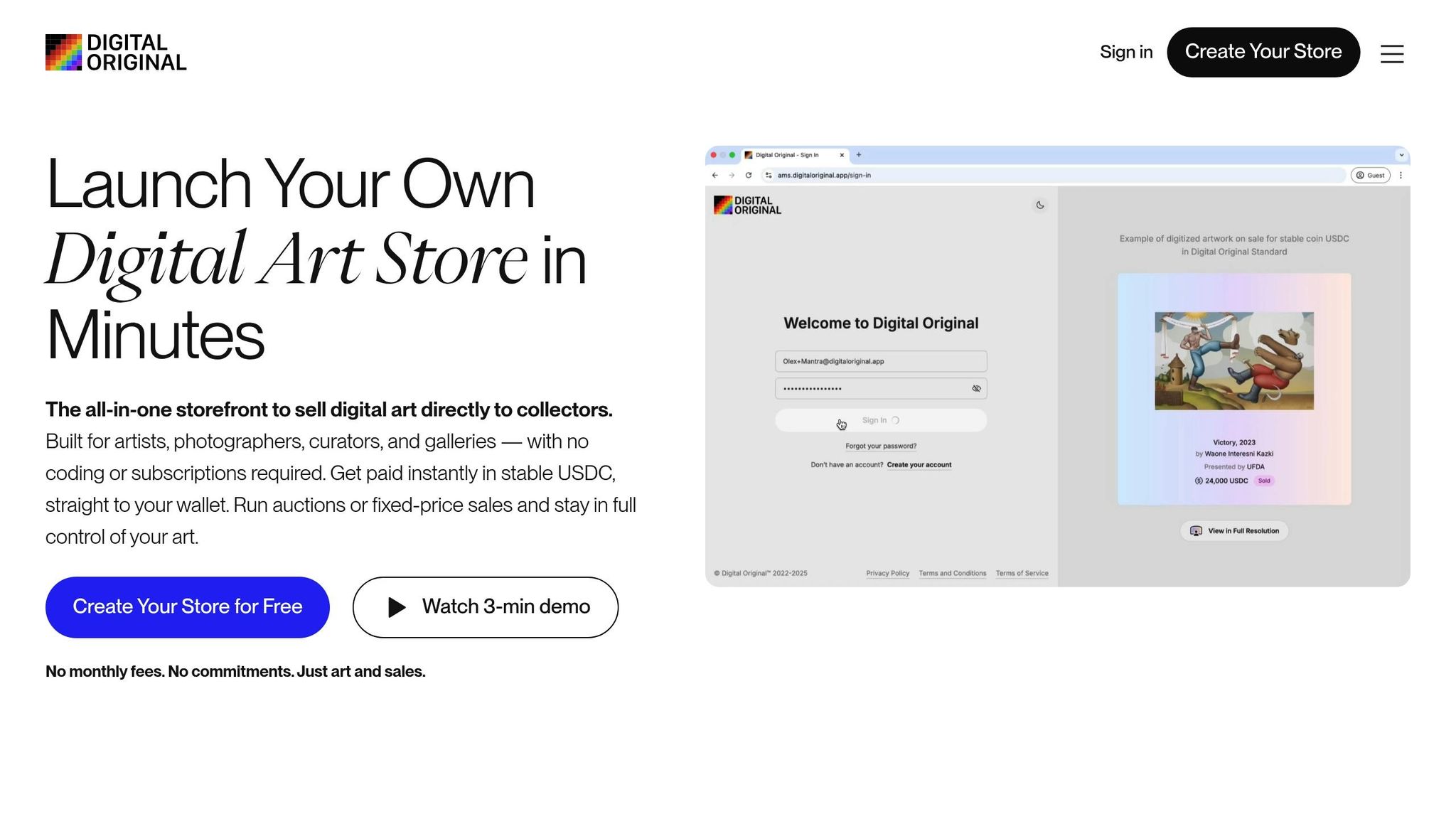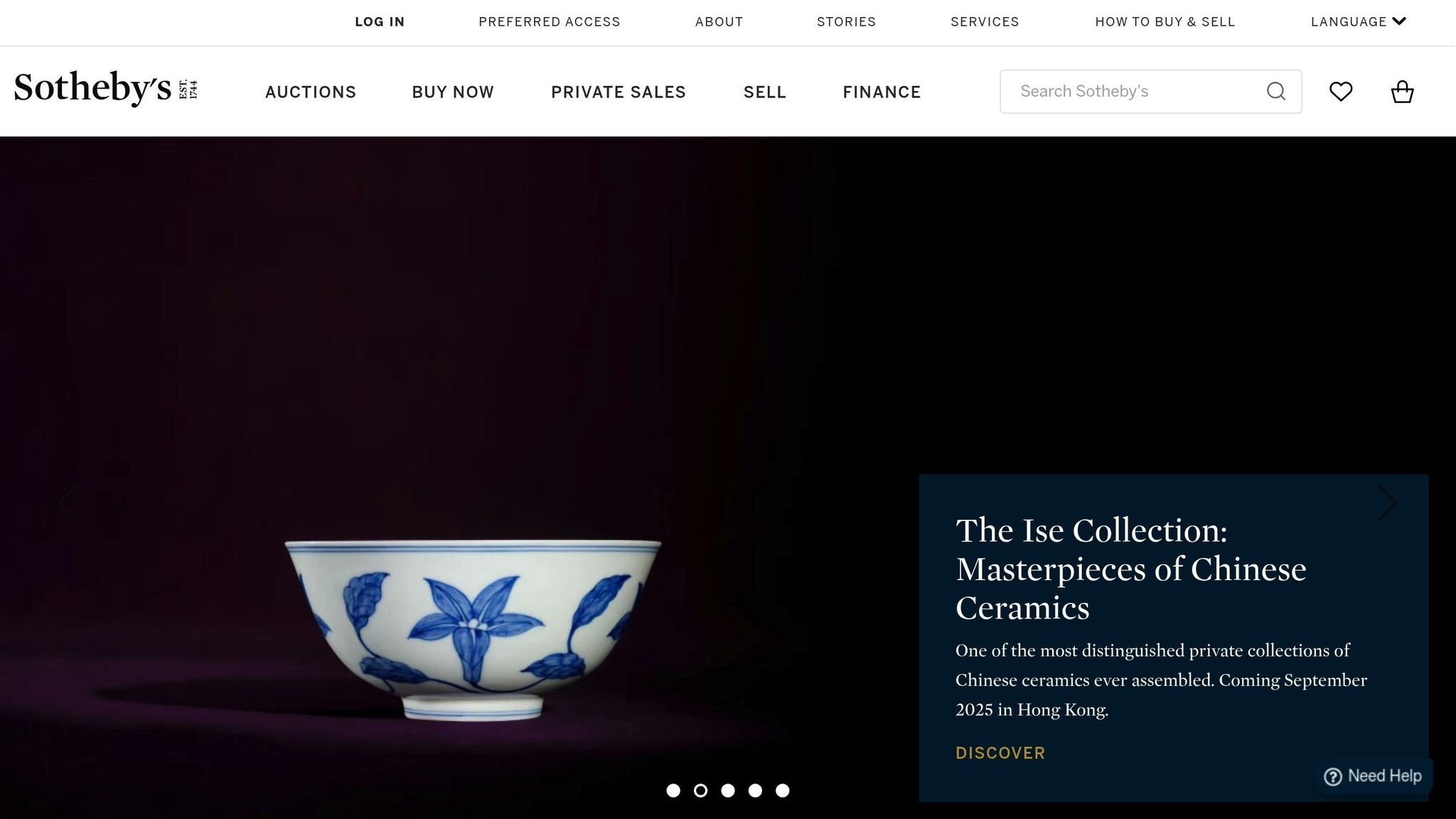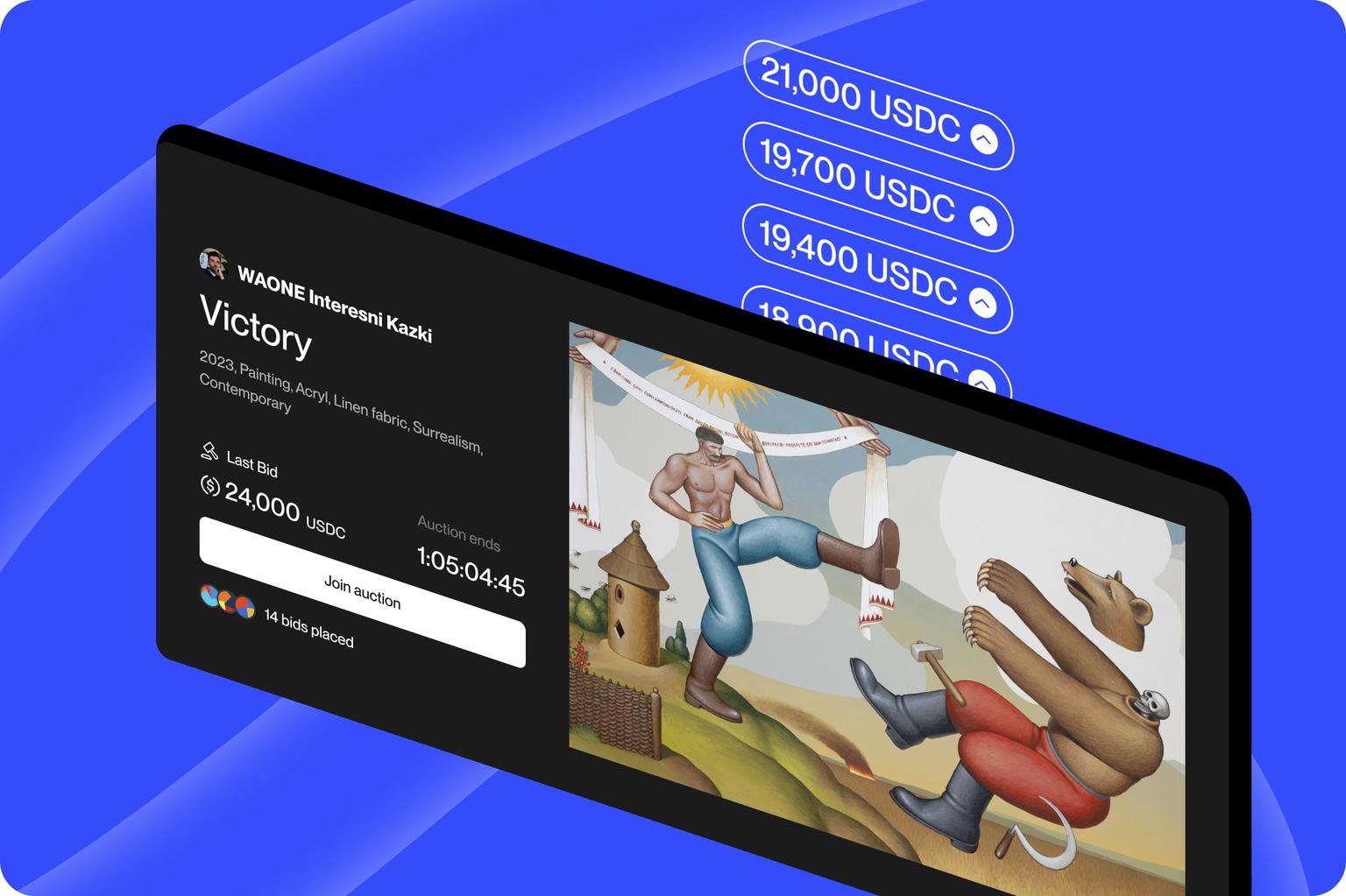Digital Art Auctions: What Collectors Need to Know
Digital art auctions are reshaping how people buy and sell art, with a booming market projected to grow at 17.3% annually through 2032. By leveraging blockchain technology, these auctions provide secure ownership records and global access. Here’s what you need to know:
- How It Works: Digital art auctions use blockchain to create NFTs (non-fungible tokens), which act as proof of ownership. Buyers bid online, and the highest bidder receives the NFT, ensuring transparency and authenticity.
- Why It Matters: These auctions eliminate geographical barriers, reduce fraud, and often have lower fees than physical galleries. Artists also benefit from automatic royalties for resales.
- Getting Started: You'll need a cryptocurrency wallet (commonly Ethereum-based) funded with crypto like USDC. Research artists and platforms to make informed bids.
- Platforms: Options like Digital Original, Sotheby’s, and OpenSea cater to different needs, from curated collections to open marketplaces.
Digital art auctions make collecting more accessible, secure, and efficient. Whether you’re a seasoned collector or new to the space, understanding how these systems work is key to navigating this fast-growing market.
What Is a Digital Art Auction?
A digital art auction is an online platform where collectors bid on digital artworks, which exist as files rather than physical objects. These auctions rely on blockchain technology to create non-fungible tokens (NFTs). These NFTs act as digital certificates of ownership, ensuring the authenticity of the artwork and verifying who owns it.
Unlike traditional auctions held in physical galleries, digital art auctions take place entirely online. Once the auction ends, the highest bidder receives a unique NFT as proof of ownership.
How Digital Art Auctions Work
Digital art auctions are hosted on specialized platforms that manage everything from displaying the artwork to handling the bidding process. Artists upload their digital creations - whether they are illustrations, animations, or even interactive media - along with details like starting prices and edition sizes.
Before the sale begins, the platform converts the artwork into an NFT, assigning it a unique identifier on the blockchain. Collectors link their cryptocurrency wallets to the platform and place their bids.
Typically, these auctions last for a set period, often between 24 and 72 hours. The platform provides real-time updates, showing the current highest bid and how much time remains. When the auction closes, the highest bidder receives the NFT directly in their wallet, and the payment (minus platform fees) is transferred to the artist.
Some platforms also offer additional options, such as fixed "Buy Now" prices or reserve auctions, where the artwork is sold only if bidding reaches a minimum price set by the artist.
Why Collectors Should Care About Digital Art Auctions
Digital art auctions break down many of the traditional barriers that have made art collecting difficult. Geography is no longer a limitation - anyone with internet access can bid on works from top digital artists, regardless of their location.
Blockchain technology adds a layer of transparency by recording an artwork's entire history, including past sales and ownership transfers. This helps collectors make informed decisions and reduces the risk of purchasing fraudulent pieces.
Additionally, these platforms often charge lower fees than traditional galleries, making the process more cost-effective. With auctions running 24/7, collectors can explore, research, and bid whenever it suits them.
The global nature of digital auctions also attracts a larger audience, increasing competition and often driving up prices for high-quality pieces. For artists, this means they’re no longer limited to local buyers or gallery networks when selling their work.
Next, we’ll dive deeper into the step-by-step process of how these auctions work, from placing bids to transferring NFTs.
How Digital Art Auctions Work for Collectors
Digital art auctions combine traditional auction mechanics with blockchain technology, creating a seamless way for collectors to acquire unique pieces. Each step in the process is essential, and understanding these phases can help collectors secure their desired artwork. This method also benefits from the transparency and security that blockchain offers. Let’s dive into how to set up your wallet and start bidding.
Setting Up a Digital Art Auction Wallet
Before you can participate in a digital art auction, you’ll need a cryptocurrency wallet that supports Ethereum. This wallet will act as your gateway to bidding and purchasing.
Start by creating your wallet and funding it with cryptocurrency or stablecoins. Many collectors prefer using USDC (USD Coin) because its value is tied to the U.S. dollar, which helps minimize the volatility often associated with other cryptocurrencies. Don’t forget to add a little extra to cover gas fees - these are transaction fees on the blockchain that can range from $5 to $50, depending on network activity. During peak times, these fees may rise significantly.
Protecting your wallet is crucial. Store your seed phrase - a 12- to 24-word recovery code - in a secure location. This phrase is your only way to recover access if your wallet is lost or compromised. Treat it like the key to your digital vault.
How to Bid and Win Digital Art
The bidding process is now managed by smart contracts, which automate transactions and ensure fair play. Most platforms host timed auctions, where collectors can place bids over a set period, typically lasting 24 to 72 hours.
To place a bid, you’ll connect your wallet to the auction platform and approve the transaction. If someone outbids you, your funds are automatically returned to your wallet. Many auctions use a reserve price system, meaning the artwork will only sell if bidding reaches a minimum amount set by the artist. Some platforms also include automatic bid extensions - if a bid is placed in the final minutes, the auction may extend by an additional 10 to 15 minutes to discourage last-second bids.
Before bidding, it’s wise to research the artist’s previous sales and current market trends. Be aware that platform fees, typically ranging from 5% to 15% of the final sale price, will be added to your winning bid.
If you win, the process of transferring ownership is quick and efficient.
Getting Your Digital Art After Winning
After the auction ends, the NFT (non-fungible token) is transferred directly to your connected wallet. This usually takes just a few minutes as the blockchain verifies the transaction and updates the ownership record.
The NFT serves as proof of ownership and includes metadata linking to the actual art file. These files are often stored on decentralized networks like IPFS (InterPlanetary File System) to ensure they remain accessible over time.
You can view your NFT in your wallet or on platforms designed for displaying digital art. The blockchain also keeps a detailed record of the NFT’s history, including its creation date, past sales, and current owner.
For high-value pieces, many collectors enhance security by transferring their NFTs to hardware wallets like Ledger or Trezor. Some platforms may also provide high-resolution downloads of the artwork for personal use, though the specific usage rights will depend on the terms set by the artist.
Top Platforms for Digital Art Auctions
When it comes to digital art auctions, the platform you choose can significantly impact transaction costs, speed, and the overall experience. Collectors have access to a variety of platforms, each with its own strengths. Here's a closer look at some of the most notable options and what they bring to the table.
Digital Original Platform Features

Digital Original sets itself apart by allowing artists and galleries to create custom storefronts without any upfront costs or monthly fees. Sales are managed through smart contracts, with payments processed in USDC (USD Coin). This ensures instant payouts while minimizing concerns about price volatility.
The platform supports both auction and fixed-price sales. Winning an auction means ownership is immediately transferred to your wallet, and the artist gets paid right away. Additionally, Digital Original offers a strong verification system, providing authenticated ownership records and detailed provenance information. This makes it easier for collectors to confirm the authenticity of a piece before placing a bid.
Sotheby's and OpenSea Digital Art Sales

Sotheby's brings its reputation as a traditional auction house into the digital art world. It focuses on curated auctions featuring well-known artists, often with higher-value pieces. However, buyers should be aware of traditional premiums that are added to the final price.
OpenSea, on the other hand, operates as a massive open marketplace with an extensive range of listings at various price points. While it offers accessibility and variety, collectors should factor in additional transaction and network fees, which can influence the total cost of a purchase.
Platform Feature Comparison
Each platform has distinct features and advantages, catering to different types of collectors and artists:
- Payment Speed: Digital Original processes USDC payments instantly, ensuring quick transactions. Sotheby's may take several business days for wire transfers, while OpenSea's payment speed depends on blockchain network congestion.
- Fees: Digital Original charges a 5–15% fee only when a sale is made and includes built-in royalties for artists. Sotheby's applies traditional buyer premiums, and OpenSea charges a base fee along with potential network fees.
- Authentication: Digital Original offers detailed provenance tracking and artist verification. Sotheby's relies on its established authentication processes, while OpenSea uses blockchain records to confirm ownership.
- Customization and Tools: Digital Original provides tools for storefront customization and direct communication between artists and collectors. Sotheby's offers high-profile exposure through curated auctions, while OpenSea focuses on marketplace functionality with advanced filtering and discovery tools.
- User Experience: Digital Original prioritizes simplicity and direct artist–collector interactions. Sotheby's maintains a formal, traditional auction atmosphere with detailed lot descriptions. OpenSea, meanwhile, emphasizes variety and ease of navigation with its broad range of listings.
Each platform caters to different needs, whether you're looking for direct artist connections, high-value curated auctions, or a vast marketplace with diverse options.
sbb-itb-4e84554
3 Things Most People Get Wrong About Digital Art Auctions
Digital art auctions often attract newcomers who bring along misconceptions from the world of traditional art collecting or misunderstandings about blockchain technology. These misconceptions can lead to poor bidding decisions, unrealistic expectations, or missed opportunities.
Let’s break down what NFT ownership really involves and how blockchain technology plays a role.
What NFT Ownership Actually Means
One common misunderstanding is about what you actually own when you win an NFT at a digital art auction. What you’re purchasing is a verified record of ownership, not the image file itself. While owning an NFT allows you to display, sell, or trade it, the original artist typically retains the copyright unless explicitly stated otherwise.
This ownership record is stored permanently on the blockchain, providing an indisputable and verifiable history of the artwork. This feature eliminates any disputes over provenance, ensuring that ownership details are clear and trustworthy.
How Blockchain Records Work
Another concern among potential collectors is the fear that blockchain transactions might compromise their privacy. However, blockchain systems are designed to balance transparency with anonymity. Transactions are tied to public wallet addresses (e.g., "0x1a2b3c…") rather than personal details. Unless you choose to share additional information, your identity remains private.
This transparency allows anyone to trace an artwork's ownership history, review previous sale prices, and confirm its authenticity. Every transaction is permanently recorded, making the blockchain a powerful tool for verifying and authenticating digital art.
With these technical points clarified, let’s address some of the most common myths about digital art auctions.
Common Myths vs Facts
-
Myth: "Anyone can right-click and save the image, so NFTs are worthless."
Fact: Right-clicking only creates a copy, much like taking a photo of the Mona Lisa doesn’t give you the original. NFT ownership provides verifiable scarcity and provenance that a simple downloaded image can’t replicate. -
Myth: "Digital art auctions are just speculation with no real value."
Fact: Just like traditional art, digital art can hold real market value based on factors like the artist’s reputation, collector demand, and its broader cultural significance. -
Myth: "The blockchain uses too much energy, making digital art environmentally harmful."
Fact: Many platforms now operate on energy-efficient blockchains that use advanced consensus mechanisms, drastically reducing energy consumption compared to older systems. -
Myth: "You need technical expertise to participate in digital art auctions."
Fact: Modern auction platforms have simplified the process, making it easy to set up a wallet and place bids. Participating is now as straightforward as joining any other online auction.
Key Takeaways
Digital art auctions have revolutionized the way art is collected. By leveraging blockchain technology for secure and transparent transactions and breaking down geographic barriers, these auctions open up opportunities that traditional art markets simply couldn't provide.
Main Benefits of Digital Art Auctions
- Global Access: Digital art auctions allow collectors to participate from anywhere, 24/7. This accessibility has helped online art sales grow to represent about 25% of the global art market in 2024.
- Secure Transactions and Clear Ownership: Blockchain technology ensures a tamper-proof record of ownership and provenance, addressing long-standing concerns about fraud.
- Fair Artist Compensation: Smart contracts ensure artists receive royalties automatically when their work is resold, providing them with ongoing recognition and payment for their creations.
- Data-Driven Insights: Tools powered by real-time analytics and AI provide collectors with valuable information on pricing and market trends, making it easier to make informed decisions.
How Collectors Can Get the Most Value
To truly benefit from digital art auctions, collectors can adopt strategies that maximize their experience and returns.
- Preparation is Key: Secure a verified wallet, familiarize yourself with bidding guidelines, and research auction rules to ensure a smooth experience.
- Choose the Right Platform: The platform you select plays a big role in your success. Look for those with strong security measures, clear bidding processes, seamless wallet integration, and robust NFT transaction support. For instance, platforms like Digital Original offer features like customizable storefronts and instant USDC payouts, ensuring both security and efficiency.
- Stay Informed: Keep up with market trends and emerging artists. With 43% of galleries expected to focus more on online sales by 2025, staying ahead of trends can help you identify valuable opportunities early.
- Diversify Your Collection: Build a well-rounded collection by including works from both established artists and emerging or underrepresented creators. This approach not only spreads risk but also supports a broader artistic community.
- Adapt to Market Trends: Recent statistics show that 73% of collectors purchased as much or even more art online in 2024 compared to 2023. By understanding these patterns and choosing the right platforms, collectors can position themselves to thrive in the growing digital art market.
FAQs
How do digital art auctions verify authenticity and ownership of artworks?
Digital art auctions now rely on blockchain technology and digital certificates to ensure artworks are genuine and ownership is indisputable. Blockchain functions as a secure and transparent ledger, keeping a permanent record of every transaction. This way, ownership details are tamper-proof and immune to counterfeiting.
A significant number of digital artworks are linked to NFTs (non-fungible tokens), which act as digital proof of ownership and authenticity. These tokens store detailed information about the artwork’s history, making it straightforward for collectors to verify its origins. This combination of blockchain and NFTs gives buyers peace of mind while safeguarding against fraud.
What’s the difference between digital art auctions and traditional art auctions?
The main difference between the two lies in their format and what ownership entails. Digital art auctions revolve around NFTs (non-fungible tokens), which are digital assets recorded on a blockchain. These tokens provide a secure way to verify authenticity, transfer ownership, and establish proof of possession - all without the need for a physical item. In contrast, traditional art auctions focus on physical artworks, where ownership means holding a tangible piece of art.
Another key factor is accessibility. Digital auctions take place online, making it possible for anyone around the globe to participate from the comfort of their home. Traditional auctions, however, are often held in physical venues, requiring bidders to either attend in person or rely on intermediaries. This makes digital auctions a more convenient and inclusive option for collectors worldwide.
How can a new collector prepare for their first digital art auction?
Before diving into your first digital art auction, it's essential to do some groundwork. Start by exploring the platform you'll be using. Get a solid understanding of how to register, how the bidding process works (whether it's manual or automated), and carefully read through the auction's terms. Pay close attention to details like fees and accepted payment methods so there are no surprises later.
Next, set a firm budget to keep your spending in check. It's easy to get caught up in the excitement, so having a clear limit will help you stay on track. Take the time to research the artwork you're eyeing. Learn about its value, history, and authenticity - this knowledge not only boosts your confidence but also ensures you're making well-informed bids.
With the right preparation, you'll be ready to enjoy a smooth and rewarding auction experience.





